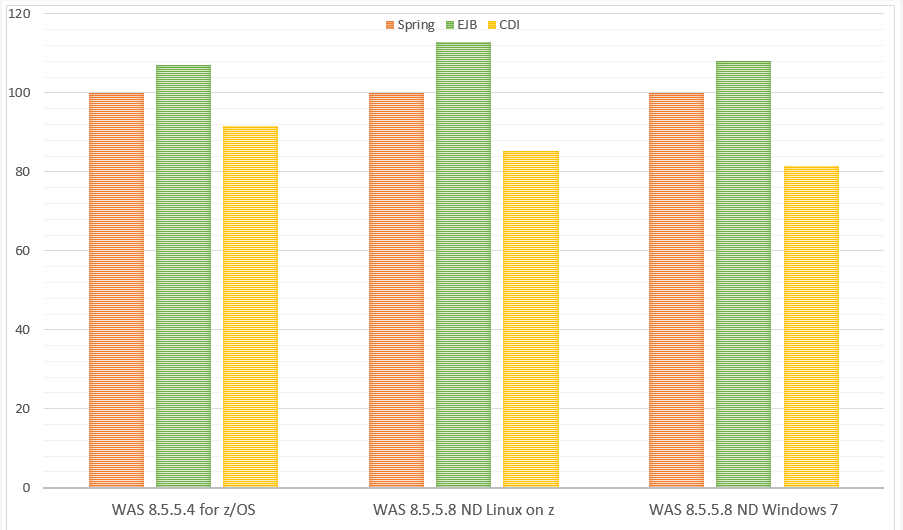A very popular delusion in the Java world is the Spring Framework provides better performance than good old Enterprise Java Beans. The best approach to compare technologies is just to get a benchmark. This repository contains three implementations of the same simple RESTful web-service based on Spring MVC, EJB and CDI, respectively. The service design is the following: resource providers are injected into a "service" class and the "service" is injected into a controller. This is the usual design of an enterprise application: data-access objects are injected into services and the services are injected into facades or controllers. Different technologies are used for Dependency Injection as well as RESTfulization.
Let's have a look at the EJB version.
Resource:
@Stateless
public class EJBResourceA {
public String message() {
return "A#" + System.currentTimeMillis();
}
}Service:
@Stateless
public class MessageService {
@EJB
private EJBResourceA aresource;
@EJB
private EJBResourceB bresource;
public String message() {
return aresource.message() + bresource.message();
}
}REST Controller:
@Stateless
@Path("/")
public class MessageController {
@EJB
private MessageService service;
@GET
@Path("/message")
@Produces({"text/plain"})
public String message() {
return service.message();
}
}The service just returns a string built by some letters and current time concatination:
JMH is a Java harness for building, running, and analysing nano/micro/milli/macro benchmarks written in Java and other languages targetting the JVM.
The benchmark code contained by the file.
Now it is time to destroy the myth!
# java -jar rest-benchmark/target/rest-benchmarks.jar ".*Benchmark" -f 4 -wi 20 -i 20 -t 4
-si true -gc true
Where:
-f [int]- How many times to forks a single benchmark.-wi <int>- Number of warmup iterations to do.-i <int>- Number of measurement iterations to do.-si [bool]- Synchronize iterations?-t <int>- Number of worker threads to run with.-gc [bool]- Should JMH force GC between iterations?
Allowed parameters:
server- application server's host,localhostis the default value.port- application server's port.path- path for the resource. Every path is relative to the/api/catalog.implementation- technology used for the RESTful service implementation. The passed values are just substituted in therest-ws-{implementation}template for web-applications context-roots.
Example:
# java -jar rest-benchmark/target/rest-benchmarks.jar ".*Benchmark" -f 4 -wi 20 -i 20 -t 4
-si true -gc true -p port=14633 -p implementation=ejb,cdi
The test results data - troughput - are normalized (the Spring Framework is 100%, bigger value is better):
EJB is up to 15% faster than the Spring Framework while CDI is up to 19% slower.
 |
IBM Mainframe zBC 12: 2 General CP + 1 zIIP, 32 GB RAM, z/OS 2.1, IBM J9 VM R26 SR7 based on Oracle 7u55-b13 |
Operations per second, the picture is clickable:
 |
IBM Mainframe zBC 12: 2 IFL, 16 GB RAM, SUSE Linux Enterprise Server 12 s390x, IBM J9 VM R27 SR3 based on Oracle 7u85-b15 |
Operations per second, the picture is clickable:
 |
Lenovo ThinkPad T440: 2 Intel i5-4300U @ 1.90 GHz, 8 GB RAM, Windows 7 x64, IBM J9 VM R27 SR3 based on Oracle 7u85-b15 |
Operations per second, the picture is clickable:
Which result have you gone? Please, share it with me: [email protected]




